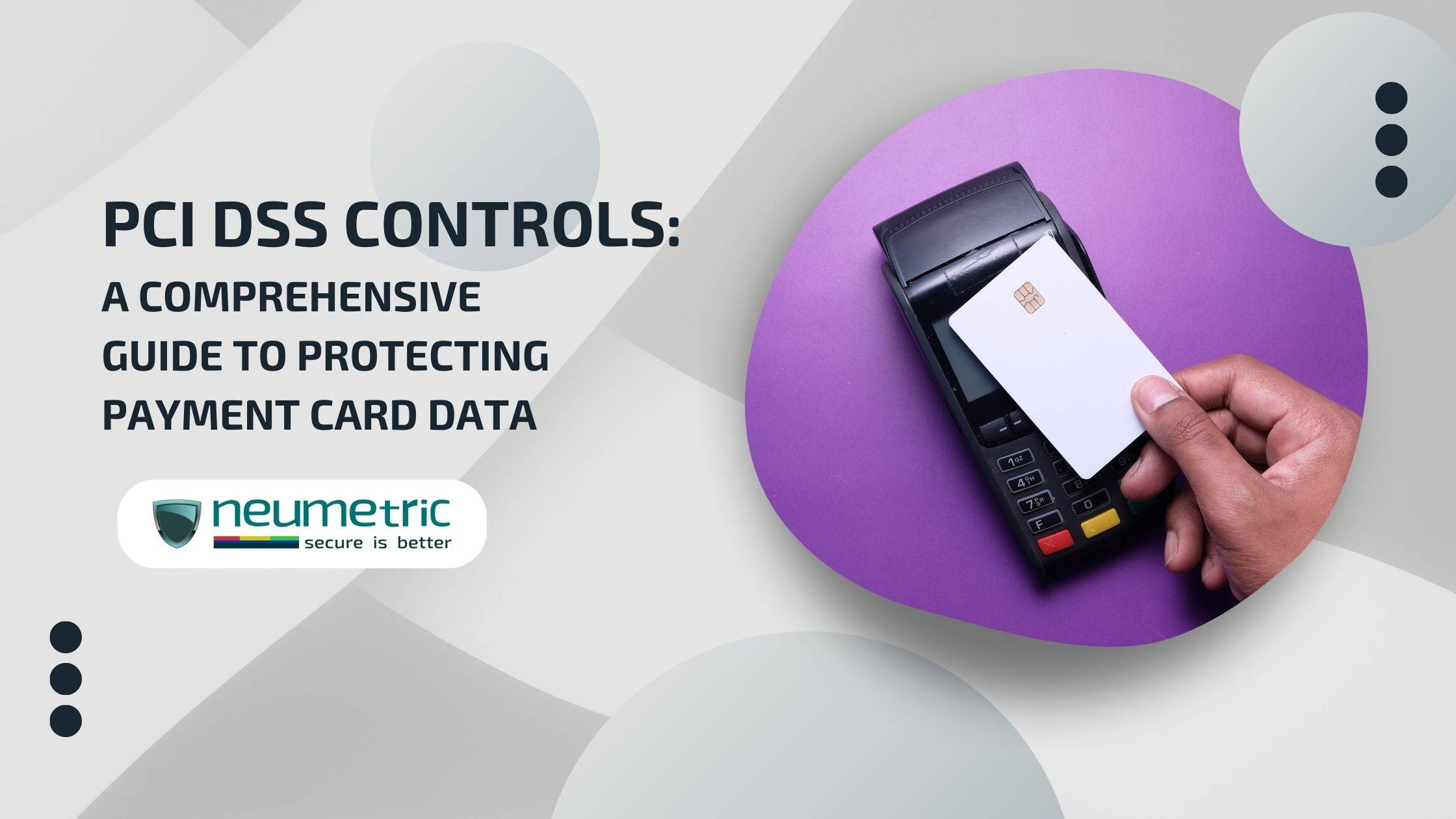Table of Contents
TogglePCI DSS Controls: A Comprehensive Guide
Introduction
PCI DSS stands for Payment Card Industry Data Security Standard. PCI DSS has been around for many years now & when it was first introduced, it was seen as a burden by merchants. However, in the last few years, PCI DSS Controls has become more important than ever before due to the recent data breaches that have affected various Companies. While implementing PCI DSS Controls is challenging for most Organisations because of the extensive requirements that they have to follow, there are ways in which merchants can make sure that their Payment Card Data remains protected by better understanding these controls.
PCI DSS is a set of requirements that help Organisations prevent Card Data theft, & it is not a Law but rather a set of Guidelines that are recommended by the payment brands. The PCI DSS Controls is a Global Standard, meaning that all merchants around the world must comply with it in order to accept Credit Cards from their Customers. The goal of this Journal is to explain what PCI DSS Controls are, why they are necessary & how you can implement them in your Organisation.
Understanding PCI DSS Controls
PCI DSS Controls are a set of standards that help Organisations that handle Credit Card information to protect against data breaches & theft. PCI DSS was developed by the major Credit Card Companies to provide a baseline for protecting sensitive Cardholder Data.
PCI DSS Controls are important because they help Organisations reduce the risk of data breaches & protect sensitive Cardholder information. Compliance with these Controls is mandatory for any Organisation that accepts Credit Card payments. Failure to comply can result in fines, legal action, & damage to a Company’s reputation. There are three main types of PCI DSS Controls: Administrative Controls, Technical Controls & Physical Controls.
- Administrative Controls refer to Policies, Procedures, & Training that help manage the security of Cardholder Data. Examples of Administrative Controls include:
- Security policies: These are formal Documents that define the Company’s approach to protecting Sensitive Data. They should include information on how Data is stored, who has access to it, & how it should be disposed of when it’s no longer needed.
- Security awareness training: Regular training & education sessions should be held to help Employees understand the importance of Data Security & how to comply with Security Policies.
- Access controls: This includes defining who has access to sensitive data & what level of access they have.
- Technical controls refer to Software, Hardware, & other Technical Measures used to protect Sensitive Data. Examples of Technical Controls include:
- Firewalls: These are used to control network traffic & prevent unauthorised access.
- Encryption: This is the process of converting Sensitive Data into a format that can only be read by Authorised Parties.
- Antivirus Software: This is used to protect against malware & other types of malicious software.
- Physical Controls refer to measures that are put in place to physically protect Sensitive Data. Examples of physical controls include:
- Access Controls: Physical access to Sensitive Data should be restricted to ONLY to Authorised Personnel.
- CCTV: Closed-Circuit Television [CCTV] can be used to monitor areas where Sensitive Data is stored or processed.
- Secure storage: Sensitive Data should be stored in a secure location, such as a locked Server room or a secure Data Centre.
Benefits of Implementing PCI DSS Controls
The implementation of PCI DSS Controls has several benefits for Organisations that handle Credit Card information. In this section, we will discuss some of the benefits that come with implementing PCI DSS Controls.
- Increased Security: The primary benefit of implementing PCI DSS Controls is an increased level of security for Sensitive Data. The Controls require Organisations to adopt security best practices, which reduce the risk of data breaches, theft, or fraud. By implementing PCI DSS Controls, Organisations can protect against both Internal & External threats, which in turn helps maintain Customer Trust.
- Reduced Risk of Breaches: PCI DSS Controls aim to reduce the risk of data breaches, which can have a severe impact on an Organisation’s reputation & financial stability. By implementing the Controls, Organisations can reduce the risk of data breaches & avoid the costs associated with such incidents. This includes financial penalties, legal costs, & damage to the Organisation’s reputation.
- Improved Customer Trust: Implementing PCI DSS Controls can help Organisations build trust with their Customers. Customers are increasingly concerned about the security of their Personal Information, & by demonstrating compliance with PCI DSS Controls, Organisations can provide assurance that they take data security seriously.
- Compliance with Industry Standards: Compliance with PCI DSS Controls is mandatory for any Organisation that accepts Credit Card payments. Compliance demonstrates that an Organisation meets the minimum standards for protecting Sensitive Data. Meeting these Standards can also help Organisations comply with other Regulations, such as GDPR or HIPAA.
Real-world examples of Companies that have successfully implemented PCI DSS Controls & seen positive results include:
- Airbnb: In 2018, Airbnb implemented PCI DSS Controls to protect against Payment Card fraud. By implementing these Controls, Airbnb was able to improve the security of their payment system, reduce the risk of fraudulent transactions, & maintain Customer Trust.
- PayPal: PayPal is a Company that has always placed a high priority on security. The Company has implemented PCI DSS Controls to protect against data breaches & improve Customer Trust. By doing so, PayPal has been able to maintain its position as a leading provider of online payment services.
Key Components of PCI DSS Controls
PCI DSS Controls are designed to ensure the security of Payment Card Data & protect it against theft, fraud, & misuse. In this section, we will discuss the key components of PCI DSS Controls & provide examples of specific controls that fall under each component.
Access Control Measures: Access Control measures are put in place to ensure that ONLY Authorised Personnel have access to Payment Card Data. This includes controls such as Password Management, Access Controls, & Multi-Factor Authentication [MFA]. Specific controls that fall under Access Control measures include:
- Unique IDs & passwords for each user
- Role-based access control
- Physical access controls to servers & network devices
- Firewall & router configurations that restrict access to Payment Card Data
- Limiting access to sensitive data on a “need to know” basis
Network Security: Network security controls aim to secure Payment Card Data during transmission over networks. This includes measures such as Network Segmentation, Firewalls, Intrusion Detection & Prevention Systems [IDPS] & Secure Remote Access. Specific controls that fall under network security include:
- Installation of Firewalls & Intrusion Detection & Prevention Systems [IDPS]
- Restricting inbound & outbound traffic to specific IP Addresses
- Regularly testing network security with Vulnerability Assessments & Penetration Tests
- Deploying Network Segmentation to separate Payment Card Data from other network traffic
Encryption: Encryption is the process of encoding Payment Card Data so that it cannot be read by Unauthorised Parties. Encryption helps to ensure that Payment Card Data is secure when it is stored & transmitted. Specific controls that fall under encryption include:
- Use of strong encryption for Payment Card Data in transit & at rest
- Encryption of this data during transmission over public networks
- Use of cryptographic keys & digital certificates to protect the data
- Regular testing & verification of Encryption Controls
Physical Security: Physical Security controls aim to protect Payment Card Data by securing physical access to systems & Data Centres where the data is stored. Specific controls that fall under physical security include:
- Secure storage of Payment Card Data in locked cabinets or data safes
- Restricted access to Data Centres & Server Rooms
- CCTV surveillance & access control systems to monitor access to Data Centres & server rooms
- Regular testing & maintenance of physical security controls
Monitoring & Testing: Monitoring & Testing controls aim to detect & prevent security incidents before they occur. This includes measures such as regular Vulnerability Scans, Penetration Testing & Monitoring of Access Logs. Specific controls that fall under monitoring & testing include:
- Regular review of System Logs & Audit Trails for suspicious activity
- Implementation of Intrusion Detection & Prevention Systems [IDPS] to detect & prevent attacks
- Regular testing of security controls through Vulnerability Assessments & Penetration Testing
- Security Event & Incident Monitoring [SIEM], detection, & response
Common Challenges in Implementing PCI DSS Controls
Implementing PCI DSS Controls can be a challenging process for many Organisations. In this section, we will discuss common challenges that Organisations may face when implementing PCI DSS Controls & provide tips for overcoming these challenges.
- Lack of Resources: One of the most common challenges Organisations face is a lack of resources to implement PCI DSS Controls. This can include a lack of funding, personnel, & time. Without adequate resources, it can be difficult to meet the requirements of the Standard. To overcome this challenge, Organisations can:
- Develop a budget & plan for implementing PCI DSS Controls
- Consider outsourcing PCI DSS Compliance to a third-party vendor such as Neumetric
- Prioritise the most critical Controls & implement them first
- Seek assistance from Industry Experts or Consultants
- Insufficient Expertise: Implementing PCI DSS Controls requires expertise in Security, Compliance, & IT. Many Organisations may not have this expertise in-house, which can make it difficult to implement & maintain the necessary controls. To overcome this challenge, Organisations can:
- Train staff on PCI DSS Requirements & Controls
- Hire or contract with Security & Compliance Experts
- Attend training & educational sessions to stay up-to-date with the latest trends & best practices
- Use vendor tools that help automate & simplify Compliance activities
- Complexity: PCI DSS Controls can be complex, especially for Organisations with complex IT Environments. Understanding the Controls & how to implement them can be a challenge. To overcome this challenge, Organisations can:
- Create a detailed project plan for implementing PCI DSS Controls
- Identify & engage Key Stakeholders throughout the Organisation
- Use industry frameworks & best practices to help simplify Compliance
- Consider the use of Automation Tools to simplify & streamline Compliance activities
- Scope Creep: Scope creep occurs when the Scope of the PCI DSS assessment expands beyond the intended boundaries, making the Assessment more complicated & expensive. To overcome this challenge, Organisations can:
- Establish clear boundaries for the Assessment Scope
- Develop a detailed Plan & timeline for the Assessment
- Communicate the Scope & boundaries of the Assessment to all Stakeholders
- Conduct a Pre-assessment to identify & address any potential Scope creep issues
- Resistance to Change: Resistance to change is a common challenge when implementing new Controls. Employees may be resistant to change, & this can make it difficult to implement new Controls successfully. To overcome this challenge, Organisations can:
- Develop a Communication Plan to educate Employees on the benefits of the new Controls
- Engage Employees in the planning & implementation process
- Provide training to Employees to help them understand their Roles & Responsibilities
- Celebrate successes & milestones to maintain Employee motivation & engagement.
Conclusion
PCI DSS Controls should be implemented by all merchants who store or transmit Payment Card Data, regardless of whether they accept Cards directly or indirectly through third-party vendors such as processors, acquirers & service providers. In addition to protecting Customer Data from theft or unauthorised access by hackers, implementing these Standards can also reduce your Organisation’s exposure to litigation in the event that someone’s account information is compromised (for example due to negligence).
PCI DSS Controls are a critical part of protecting Payment Card Data & preventing it from being exposed to hackers. They are designed to help you understand what you need to do in order to comply with PCI DSS requirements, while also ensuring that your business is protected from risk. Implementing these controls can be challenging, but the benefits of doing so far outweigh any costs associated with compliance.
FAQs
What are the control objectives of PCI DSS?
The control objectives of PCI DSS include:
- Build & maintain a secure network: The first control objective is to ensure that a secure network is in place by implementing Firewalls, restricting access to Cardholder Data, & changing Default Passwords.
- Protect Cardholder Data: The second objective is to protect the Cardholder Data that is stored, processed, or transmitted. This can be achieved through Encryption, Masking, or Truncation of Cardholder Data.
- Maintain a Vulnerability Management Program: The third objective is to maintain a Vulnerability Management Program that includes regular security updates & patches, as well as periodic vulnerability scans.
- Implement strong access control measures: The fourth objective is to ensure that access to Cardholder Data is restricted ONLY to Authorised Personnel. This can be achieved through the use of Unique IDs, Passwords, & Access Control Systems.
- Regularly monitor & test networks: The fifth objective is to regularly monitor & test networks to identify & respond to any potential threats or vulnerabilities.
- Maintain an Information Security Policy: The final objective is to maintain a comprehensive Information Security Policy that addresses the protection of Cardholder Data & includes regular training & awareness programs for Employees.
How many sub controls are there in PCI DSS?
PCI DSS consists of 12 high-level requirements, which are further broken down into a total of 281 sub-controls. These sub-controls provide specific details on how to implement & meet the requirements of the Standard. The sub-controls are organised into six groups as mentioned above, each corresponding to one of the high-level requirements.
What are the 4 PCI standards?
The Payment Card Industry [PCI] has four main Security Standards, which are designed to help Organisations protect Cardholder Data & maintain a secure Payment Environment. These Standards are:
- Payment Card Industry Data Security Standard [PCI DSS]: This is the main Security Standard that applies to all Organisations that store, process or transmit Cardholder Data. It consists of 12 Requirements & is designed to help Organisations build & maintain a Secure Payment Environment.
- [PA-DSS] Payment Application Data Security Standard: This Standard applies to software vendors & developers that create Payment Applications. It provides guidance on how to develop Secure Payment Applications that are compliant with PCI DSS.
- [P2PE] Point-to-Point Encryption: This Standard provides guidance on how to implement point-to-point encryption solutions to protect Cardholder Data during transmission. P2PE solutions encrypt the Data at the point of interaction (such as a Payment Terminal) & maintain that encryption until the data reaches the Payment Processor.
- PCI PIN Transaction Security [PCI PTS]: This Standard provides security requirements for the design & manufacture of Secure PIN Entry Devices [PEDs], such as Payment Terminals & PIN Pads. It ensures that these devices are tamper-resistant & secure, & that they protect Cardholder Data during PIN entry.





